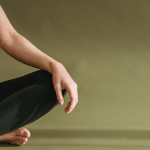Here’s what you should know before you start your kegels!
First is know your body and take responsibility for your pelvic floor. This is an individual investigation into your pelvic floor. In order to optimize your health, you need to listen to your body and respect what it is telling you. If you have an extremely tight pelvic floor and experienced pelvic pain, kegels are not going to help you and you should not do them.
In fact, until you’re able to release or learn how to relax these tight muscles using the breath or working with releasing pressure like we did with the ball work, you will only create more attention on top of tension. Imagine if you’re holding a bottle of water for let’s say 3 minutes, your arm will probably be OK if you continue to hold. For one hour, your arm will ache. 2 hours your arm will spasm. By the end of the day, you’ll probably experience a frozen shoulder, and the pain will travel to other areas of your body that you are now compensating.
This tension will disrupt your life if you do not let go of the bottle and release. Your pelvic floor is not any different. It is made of muscles like your arm. Kegels are useful if one has a weak pelvic floor that needs to be strengthened. Postpartum women and postmenopausal women fit this criteria as something has overstretched their pelvic floor muscles and made them weak. Your pelvic floor muscles are your friends, always working to support your organs, contributing to your posture and keeping you continent.
When you perform the kegel, the muscles around the front and back passages should lift and feel as if they’re lifting and squeezing up inside the pelvis. It’s also important to relax the same muscles, creating a sensation of letting go and not pushing or bearing down. Also, many people can confuse this internal squeeze action with the external action of the buttocks muscles, and they may talk or curl their bottoms under or shorten the length of the torso holding their breath.

If done correctly, there is no obvious bodily movements except for the internal lift, the squeeze sensation, and perhaps the drawing in of the low abdomen. The breast should remain soft when holding the contractions for longer in order to build endurance. When you start doing the Kegel exercises, tense the muscles in your pelvic floor for a count of three and then relax for a count of three. Keep going until you’ve done 10 repetitions. Over the next several days and weeks, practice until you can hold the muscles. Hence, for a count of 10, your goal should be to do three sets of 10 repetitions a day.
I find the key to success is listening to my body and breathing and respecting my limitations. After paying careful attention to the individual parts of my pelvic floor and making the subtle connections, I can now get a very noticeable lift. I found that also looking at the anatomy of the pelvic floor and understanding the intricacies was very helpful and can also help in building your awareness. Do the practices, be patient with yourself as you reach down deep and recreate the connections that you’ve lost or never had.









